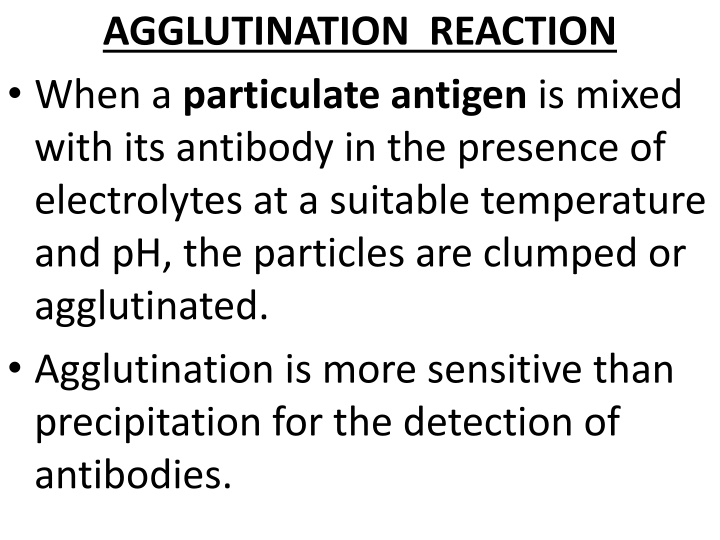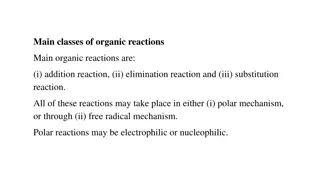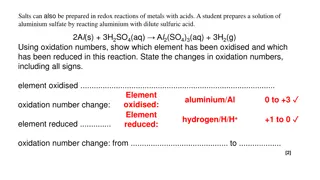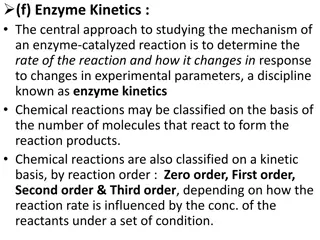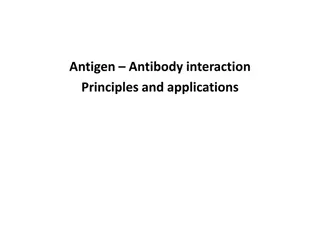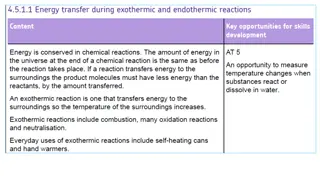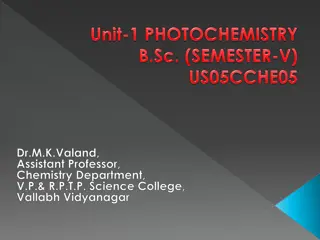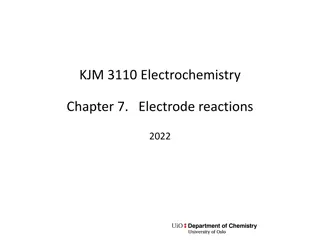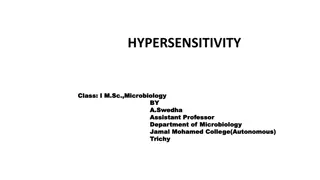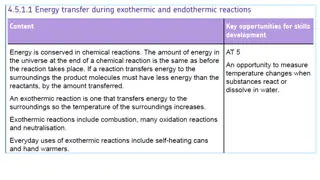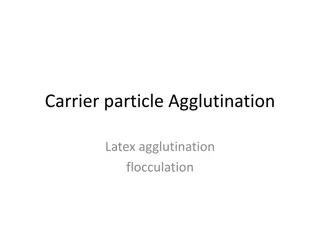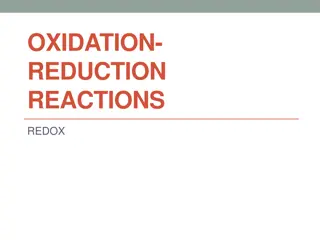Agglutination Reactions in Immunology
Agglutination reaction is a key technique in immunology where particulate antigens and antibodies clump together in the presence of electrolytes. This reaction is highly sensitive and often used for antibody detection, bacterial identification, blood grouping, and cross-matching. The process involves mixing antigen and antibody in suitable conditions, leading to visible clumping or agglutination. Different methods like slide agglutination and tube agglutination are employed based on the need for qualitative or quantitative analysis of antibodies. Understanding agglutination reactions is crucial for various diagnostic and research applications in the field of immunology.
Download Presentation

Please find below an Image/Link to download the presentation.
The content on the website is provided AS IS for your information and personal use only. It may not be sold, licensed, or shared on other websites without obtaining consent from the author.If you encounter any issues during the download, it is possible that the publisher has removed the file from their server.
You are allowed to download the files provided on this website for personal or commercial use, subject to the condition that they are used lawfully. All files are the property of their respective owners.
The content on the website is provided AS IS for your information and personal use only. It may not be sold, licensed, or shared on other websites without obtaining consent from the author.
E N D
Presentation Transcript
AGGLUTINATION REACTION When a particulate antigen is mixed with its antibody in the presence of electrolytes at a suitable temperature and pH, the particles are clumped or agglutinated. Agglutination is more sensitive than precipitation for the detection of antibodies.
Agglutination occurs optimally when antigens and antibodies react in equivalent proportions. The zone phenomenon may be seen when either an antibody or an antigen is in excess. 'Incomplete' or 'monovalent' antibodies do not cause agglutination, though they combine with the antigen.
Slide agglutination: Procedure: 1. When a drop of the appropriate antiserum is added to a smooth, uniform suspension of a particulate antigen in a drop of saline on a slide or tile, agglutination takes place. 2. A positive result is indicated by the clumping together of the particles and the clearing of the drop.
3. The reaction is facilitated by mixing the antigen and the antiserum with a loop or by gently rocking the slide. Depending on the titre of the serum, agglutination may occur instantly or within seconds. 4. Clumping occurring after a minute may be due to drying of the fluid and should be disregarded.
5. It is essential to have on the same slide a control consisting of the antigen suspension in saline, without the antiserum, to ensure that the antigen is not autoagglutinable. Agglutination is usually visible to the unaided eye but may sometimes require confirmation under the microscope.
Uses: - It is a routine procedure for the identification of many bacterial isolates from clinical specimens. - It is also the method used for blood grouping and cross-matching.
Tube agglutination: - This is a standard quantitative method for the measurement of antibodies. - When a fixed volume of a particulate antigen suspension is added to an equal volume of serial dilutions of an antiserum in test tubes, the agglutination titre of the serum can be estimated.
Uses: - It is routinely used for the serological diagnosis of typhoid, brucellosis and typhus fever. - In the Widal test used in typhoid, two types of antigens are used. - The 'H' or flagellar antigen on combining with its antibody forms large, loose, fluffy clumps resembling wisps of cotton wool. The 'O' or somatic antigen forms tight, compact deposits resembling chalk powder.
- Agglutinated bacilli spread out in a disc- like pattern at the bottom of the tubes. - The tube agglutination test for brucellosis may be complicated by the prozone phenomenon. Heterophile agglutination test : - The Weil-Felix reaction for serodiagnosis of typhus fevers is a heterophile agglutination test and is based on the sharing of a common antigen between typhus rickettsiae and some strains of proteus bacilli.
The Streptococcus MG agglutination test for the diagnosis of primary atypical pneumonia. Antiglobulin (Coombs) test: - This was devised by Coombs, Mourant and Race (1945) for the detection of anti-Rh antibodies that do not agglutinate Rh-positive erythrocytes in saline.
Principle: - When sera containing incomplete anti-Rh antibodies are mixed with Rh-positive red cells, the antibody globulin coats the surface of the erythrocytes, though they are not agglutinated. When such erythrocytes coated with the antibody globulin are washed free of all unattached protein and treated with a rabbit antiserum against human gamma globulin (antiglobulin or Coombs serum), the cells are agglutinated. (Fig.)
Types: Direct Coombs test: - The sensitisation of the erythrocytes with incomplete antibodies takes place in vivo, as in hemolytic disease of the newborn due to Rh incompatibility. - When the red cells of erythroblastotic infants are washed free of unattached protein and then mixed with a drop of Coombs serum, agglutination results.
- The direct Coombs test is often negative in hemolytic disease due to ABO incompatibility. Indirect Coombs test: - Sensitisation of red cells with the antibody globulin is performed in vitro. Uses: - Originally employed for the detection of anti-Rh antibodies, the Coombs test is useful for demonstrating any type of incomplete or non-agglutinating antibody, as, for example, in brucellosis.
Passive agglutination test: - By attaching soluble antigens to the surface of carrier particles, it is possible to convert precipitation tests into agglutination tests, which are more convenient and more sensitive for the detection of antibodies. Such tests are known as passive agglutination tests. - The commonly used carrier particles are red cells, latex particles.
Hemagglutination: - A special type of passive hemagglutination test is the Rose- Waaler test. - In rheumatoid arthritis, an autoantibody (RA factor) appears in the serum, which acts as an antibody to gamma globulin. - The RA factor is able to agglutinate red cells coated with globulins. The antigen used for the test is a suspension of sheep erythrocytes sensitised with a subagglutinating dose of rabbit anti-sheep erythrocyte antibody (amboceptor).
Latex agglutination test: - Latex agglutination tests (latex fixation tests) are widely employed in the clinical laboratory for the detection of anti- streptolysin 0 (ASO), C-reactive protein (CRP), RA factor, human chorionic gonadotrophin (HCG) and many other antigens. - Passive agglutination tests are very sensitive and yield high titres, but may give false positive results.
When, instead of the antigen, the antibody is adsorbed to carrier particles in tests for the estimation of antigens, the technique is known as reversed passive agglutination. - This method is used to diagnose bacterial antigens like Legionella, Streptococcus pyogenes and N.gonorrhoea in clinical samples.
Co-agglutination test: - It is based on agglutination of a specific antibody-sensitised protein A-bearing Staphylococcus aureus agglutinating with the soluble bacterial (e.g., Legionella) antigen in the clinical specimen.
